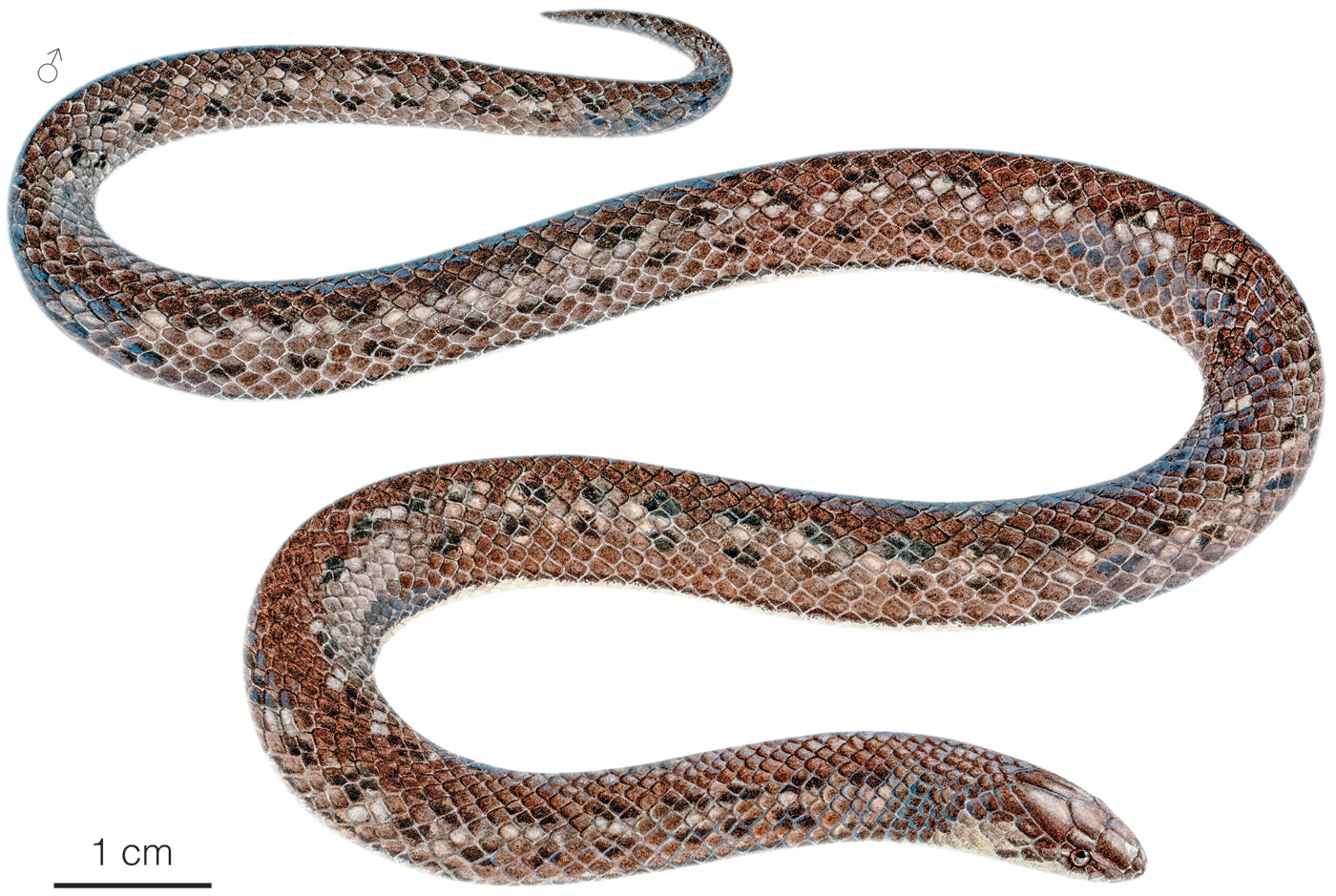Published February 23, 2024. Open access. | Purchase book ❯ |
Indistinct Ground Snake (Atractus esepe)
Reptiles of Ecuador | Serpentes | Colubridae | Atractus esepe
English common name: Indistinct Ground Snake.
Spanish common name: Tierrera indistinta.
Recognition: ♂♂ 28.5 cmMaximum distance from the snout to the tip of the tail. Snout–vent length=23.2 cm. ♀♀ 27.5 cmMaximum distance from the snout to the tip of the tail. Snout–vent length=24.1 cm..1 Atractus esepe differs from other snakes in its area of distribution by having a round head similar in width to the neck, small eyes, dorsal scales arranged in 17 rows at mid-body, and a brown dorsum with longitudinal blackish and tan lines that may be incomplete or broken into discrete spots or blotches (Fig. 1).1,2 The belly is light cream, faintly speckled with brownish pigment. Atractus esepe could be confused with A. iridescens and A. microrhynchus due to similar coloration and scale counts.1,2 However, they do not occur in western Esmeraldas province, and males of these other ground snakes have a greater number of subcaudal scales.1

Figure 1: Illustration of an adult male of Atractus esepe based on the holotype.
Natural history: Atractus esepe is a semi-fossorial snake known only from a single locality in secondary rainforest within 1–2 km from the coastline.1 The area has a mean annual temperature of 24.9ºC and a mean annual precipitation hovering around 1582 mm.2 The two known specimens were found foraging among soil and roots at night after a sunny day.1 More details about the biology and life history of A. esepe are unknown. Ground snakes in general are harmless and have a diet specialized on earthworms.3–5
Conservation: Data Deficient There is inadequate information to make an assessment of extinction risk.. Atractus esepe is a recently described species; therefore, its conservation status has not yet been formally evaluated by the IUCN. Here, it is proposed to be included in the DD category because the species belongs to a poorly studied genus of snakes and is known only from two specimens collected recently in a single rainforest locality.1 However, this forest does not appear to be isolated from other similar habitats. Therefore the species could be more widespread throughout the Chocó biogeographic region.1 Although the DD category is not considered a threat category, it is an important warning, since the only known population could be close to extinction, but due to lack of knowledge, no action can be taken.6
Distribution: Atractus esepe is known only from the type locality, Caimito, Esmeraldas province, Ecuador (Fig. 2).

Figure 2: Distribution of Atractus esepe in Ecuador. The star corresponds to the type locality: Caimito, Esmeraldas province.
Etymology: The name Atractus, which is a latinization of the Greek word άτρακτος (=spindle),7–9 probably refers to the fact that snakes of this genus have a uniform width throughout the body and a narrow tail, resembling an antique spindle used to spin fibers. The specific epithet esepe is derived from Spanish pronunciation of “sp,” an abbreviation for the word “species” that researchers often use to refer to unidentified specimens.1 This refers to the difficulty in identifying snakes of the genus Atractus.
See it in the wild: The Indistinct Ground Snake is extremely rare and has only been found in Caimito, Esmeraldas province. Additional specimens may be detected at this locality by scanning the forest floor and leaf-litter along trails at night or by searching under rocks besides roads during the day.
Author: Duvan ZambranoaAffiliation: Universidad del Tolima, Ibagué, Colombia.
Editor: Alejandro ArteagabAffiliation: Fundación Khamai, Reserva Arlequín, Ecoruta Paseo del Quinde km 56, Santa Rosa de Mindo, Pichincha 171202, Ecuador.
Illustrator: Valentina Nieto Fernández
How to cite? Zambrano D (2024) Indistinct Ground Snake (Atractus esepe). In: Arteaga A, Bustamante L, Vieira J (Eds) Reptiles of Ecuador: Life in the middle of the world. Available from: www.reptilesofecuador.com. DOI: 10.47051/UUAX5979
Literature cited:
- Arteaga A, Mebert K, Valencia JH, Cisneros-Heredia DF, Peñafiel N, Reyes-Puig C, Vieira-Fernandes JL, Guayasamin JM (2017) Molecular phylogeny of Atractus (Serpentes, Dipsadidae), with emphasis on Ecuadorian species and the description of three new taxa. ZooKeys 661: 91–123. DOI: 10.3897/zookeys.661.11224
- Mejía Guerrero MA (2018) Revisión taxonómica de las serpientes tierreras Atractus del grupo iridescens Arteaga et al. 2017. BSc thesis, Quito, Pontificia Universidad Católica del Ecuador, 67 pp.
- Martins M, Oliveira ME (1998) Natural history of snakes in forests of the Manaus region, Central Amazonia, Brazil. Herpetological Natural History 6: 78–150.
- Duellman WE (1978) The biology of an equatorial herpetofauna in Amazonian Ecuador. Publications of the Museum of Natural History, University of Kansas 65: 1–352.
- Savage JM (1960) A revision of the Ecuadorian snakes of the Colubrid genus Atractus. Miscellaneous Publications, Museum of Zoology, Univesity of Michigan 112: 1–184.
- Jarić I, Courchamp F, Gessner J, Roberts DL (2016) Potentially threatened: a Data Deficient flag for conservation management. Biodiversity and Conservation 25: 1995–2000. DOI: 10.1007/s10531-016-1164-0
- Woodward SP, Tate R (1830) A manual of the Mollusca: being a treatise on recent and fossil shells. C. Lockwood and Company, London, 750 pp.
- Beekes R (2010) Etymological dictionary of Greek. Brill, Boston, 1808 pp.
- Duponchel P, Chevrolat L (1849) Atractus. In: d’Orbigny CD (Ed) Dictionnaire universel d’histoire naturelle. MM. Renard, Martinet et Cie., Paris, 312.